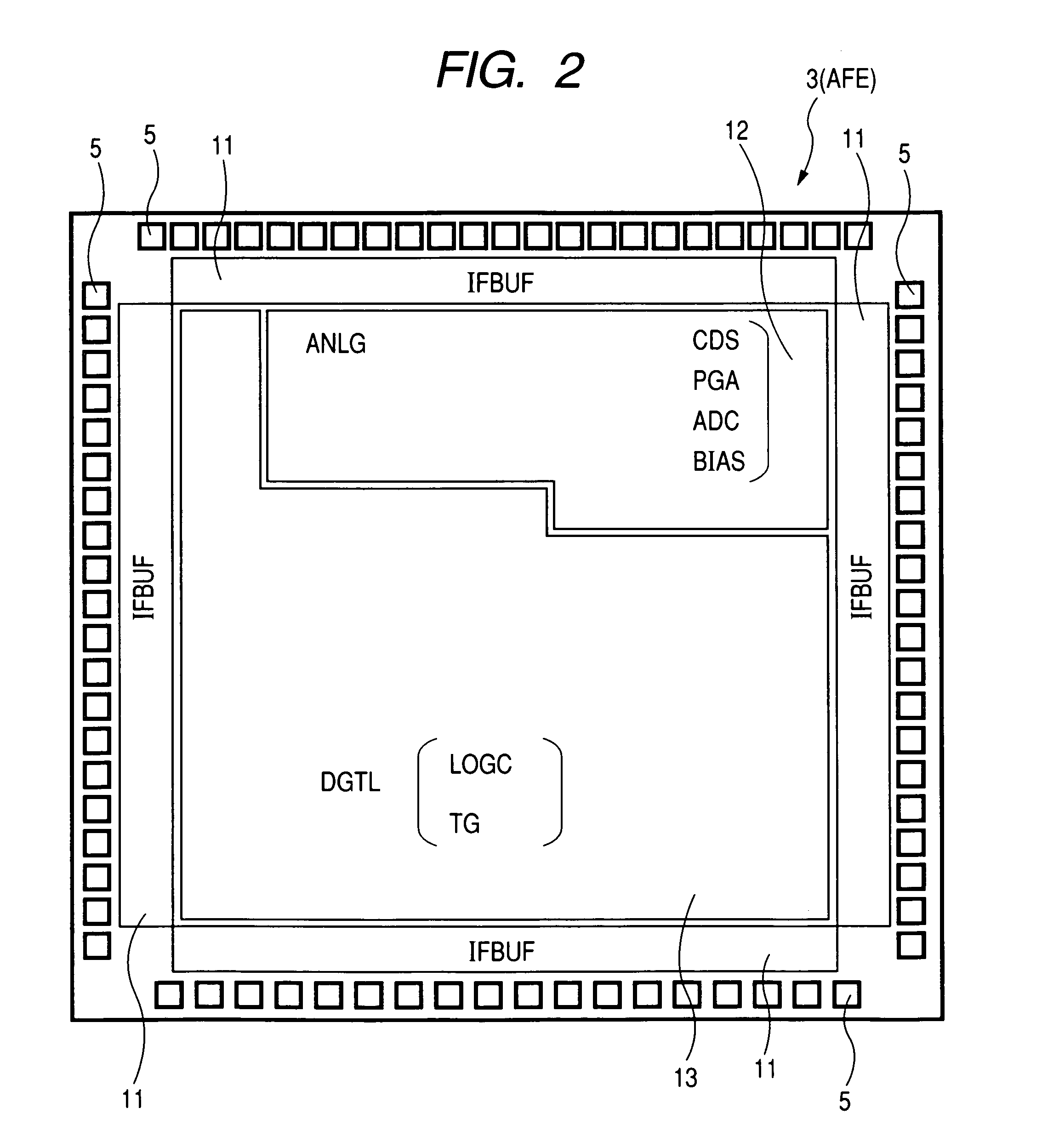[0012]The device described above has a configuration in which the bonding pads for analog signals are arranged and the edges along which the bonding pads for high-voltage signals are arranged are disposed along mutually different edges of the package substrate. Therefore, adjoining of electrodes or wirings for high voltage signals and those for analog signals over the package substrate can be easily avoided, and SI deterioration due coupling noise or the like can be thereby restrained.
[0013][2] In one typical specific mode of implementing the invention, the first semiconductor chip is arranged over the package substrate and the second semiconductor chip is arranged over the first semiconductor chip. In this configuration, the first bonding pads (7F) of the package substrate to be wire-bonded to the bonding pads (5) of the first semiconductor chip are arranged farther from the edges of the package substrate than the second bonding pads (7S) of the package substrate to be wire-bonded to the bonding pads (6) of the second semiconductor chip. To reduce the wiring length over the package substrate, it is advisable to allocate more of electrodes for external connection, to be connected to the second semiconductor chip, close to edges of the array than the electrodes for external connection, to be connected to the first semiconductor chip. In this way, it can also contribute to improving SI of the semiconductor device in the sense that the wiring length over the package substrate can be reduced.
[0014]The package substrate (2) in this configuration has first wirings (L1A and L2A) to connect the first bonding pad (7FA) to be wire-bonded to the bonding pad for analog signals of the first semiconductor chip to an electrode for external connection (25A) arranged outermost on the array. Since the outermost electrode on the array is allocated as the electrode for external connection in this configuration, it is made possible to facilitate simplification of the wiring structure over the mother board even where a noise filter or the like has to be formed by externally fitting passive components such as an inductor and a capacitor to the ball electrode for analog signals.
[0015]As described above, when the outermost electrode for external connection on the array is allocated to the bonding pad for analog signals of the first semiconductor chip, it would adjoin a digital wiring, if any, close to the wiring drawn for connection to that electrode for external connection. Or such adjoining may occur as a result of increased threading of wiring from the bonding pad for digital signals, which would have minimize the wiring route length if it were allocated to that ball electrode. Incidentally, for such threading of wiring, a second wiring can be added to connect the second bonding pad to be wire-bonded to the bonding pad for digital signals of the second semiconductor chip to an electrode for external connection arranged inner than the outermost on the array. Where wiring for analog signals adjoins wiring for digital signals, the analog signals may be affected by coupling noise. Then, even if a first wiring for connecting the bonding pads for analog signals to the outermost ball electrode on the array is threaded, all of them will not adjoin the wiring for digital signals. It is advisable to allocate wirings for analog signals less susceptible to the effects of coupling noise, such as wirings for analog signals for testing use, as the wirings for analog signals adjoining the wirings for digital signals. In this way, simplification of the wiring structure over the mother board with consideration for external fitting of circuit components can be facilitated while ensuring the minimization of SI deterioration of analog signals due to coupling with wirings for digital signals. Where another anti-noise means is to be resorted to, top priority can be given to simplification of the wiring structure over the mother board.
[0017]In this specific mode of implementing the invention, since the first semiconductor chip is arranged over the second semiconductor chip, allocation of the electrodes for external connection closer to the edges on the array for the bonding of the first semiconductor chip requires no complex wiring over the package substrate. Therefore, electrodes for analog signals for external connection to be connected to the bonding pads for analog signals of the first semiconductor chip automatically come to the outermost on the array. It is made possible to facilitate simplification of the wiring structure over the mother board even where a noise filter or the like has to be formed by externally fitting passive components such as an inductor and a capacitor to the ball electrode for analog signals. There is no restriction to make inevitable for the first and second wirings to adjoin each other, and accordingly the first wiring can be prevented from being affected by coupling the second wiring, thereby facilitating SI improvement.
 Login to View More
Login to View More  Login to View More
Login to View More 


